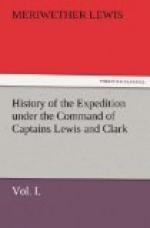Tuesday 30. Captain Clarke was this morning much restored; and, therefore, having made all the observations necessary to fix the longitude, we reloaded our canoes, and began to ascend Jefferson river. The river now becomes very crooked, and forms bends on each side; the current too is rapid, and cut into a great number of channels, and sometimes shoals, the beds of which consist of coarse gravel. The islands are unusually numerous: on the right are high plains occasionally forming cliffs of rocks and hills; while the left was an extensive low ground and prairie intersected by a number of bayous or channels falling into the river. Captain Lewis, who had walked through it with Chaboneau, his wife, and two invalids, joined us at dinner, a few miles above our camp. Here the Indian woman said was the place where she had been made prisoner. The men being too few to contend with the Minnetarees, mounted their horses, and fled as soon as the attack began. The women and children dispersed, and Sacajawea as she was crossing at a shoal place, was overtaken in the middle of the river by her pursuers. As we proceeded, the low grounds were covered with cottonwood and a thick underbrush, and on both sides of the river, except where the high hills prevented it, the ground was divided by bayous, which are dammed up by the beaver, which are very numerous here. We made twelve and a quarter miles, and encamped on the north side. Captain Lewis proceeded after dinner, through an extensive low ground of timber and meadow land intermixed; but the bayous were so obstructed by beaver dams, that in order to avoid them he directed his course towards the high plain on the right. This he gained with some difficulty, after wading up to his waist through the mud and water of a number of beaver dams. When he desired to rejoin the canoes he found the underbrush so thick, and the river so crooked, that this, joined to the difficulty of passing the beaver dams, induced him to go on and endeavour to intercept the river at some point where it might be more collected into one channel and approach




